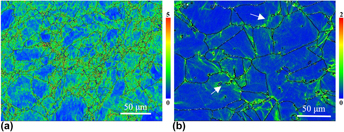Published online by Cambridge University Press: 09 January 2017

As the operating temperature of disk service was elevated from 650 °C to 700 °C, the creep properties urged to be paid attention. To investigate the creep properties of spray-formed low solvus, high refractory (LSHR) superalloy at about 700 °C, creep tests were conducted under seven different stress ranging from 690 MPa to 897 MPa. By means of creep curves and fracture microstructure observation, the creep behaviors and fracture mechanisms of spray-formed LSHR were analyzed. Stress exponent of the alloy was comparable to other disk superalloys such as Waspaloy and Inconel 718. It was interesting to find a transition in the creep behavior in two stress regimes. The contribution of grain boundary sliding in the low stress regime was greater than that in the higher stress. Under higher stress microcracks initiated along the intragranular slip bands because of strain concentration. The spray-forming LSHR exhibited a good creep resistance at low stress compared with other two superalloys by using Larson–Miller parameter, which was consistent with the transition of fracture behaviors.